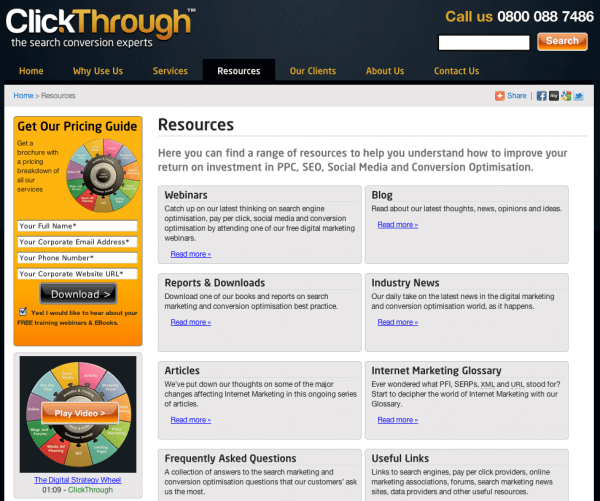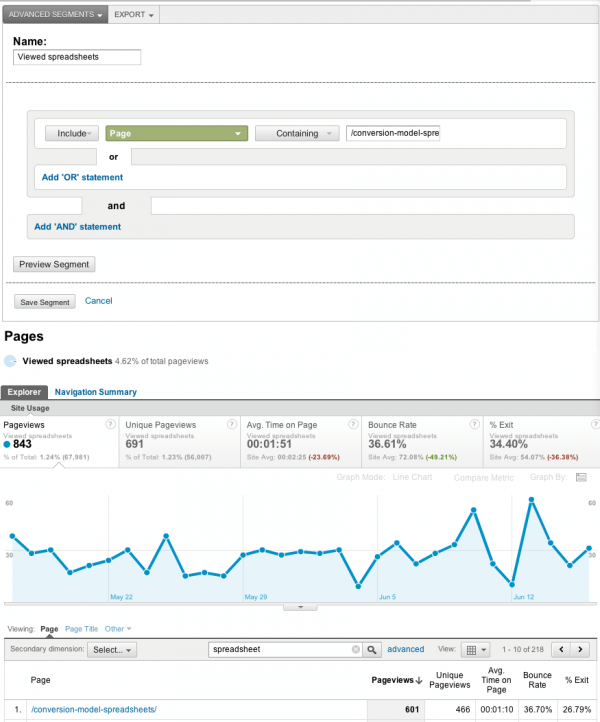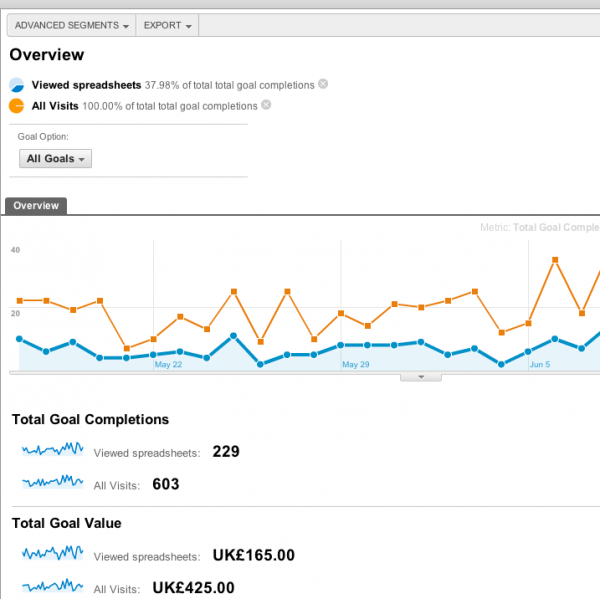A case study and examples of reviewing content marketing effectiveness in Google Analytics
In our 2 previous posts on selecting the best KPIs for reviewing content marketing effectiveness we looked at the best types of measures to use. In this post, I get into the details of how to check some of these KPIs in Google Analytics and in particular to show your efforts in creating content impact leads or sales.
Remember that we need to isolate the effect of particular content you have invested in in creating incremental leads or sales. To help do this, it's best if your site structure is setup right to measure effectively - I use the engineering term DFA "Design for Analysis" to prompt site designers think about this. I'll take some examples from ClickThrough Marketing who I have helped provide content for - around a year ago we created a series of printed 101 guides introducing search marketing concepts.
To separate your content marketing content from other product or service content you can use these approaches:
- 1. Setup your content on a separate content marketing campaign domain or subdomain. This can be the quickest way to get up and running with content marketing, if you want to use a funky design or a simple landing page which isn't possible through your main content management system. At ClickThrough we setup a separate domain initially http://www.101guideseries.com with its own Google Analytics tags. You can see the landing page format which I recall gave us a conversion rate of c68% in the original version with no navigation options available. Generally though, the next approach of grouping your content for content marketing in a subfolder is better since then your content is integrated with your main site content and users can view your content marketing and browse and return to view information about your products and services. It's also easier to track with a single domain although you can call the Google Analytics SetAllowLinker" function to link tracking with cookies across domains or subdomains.

- 2. Use sub-folder(s) on your main site to group your content. This is probably the most common approach for content marketing where you group all your content marketing like PDFs in one or more folders. At the end of the post I'll show you how to use Advanced Segments to track how this content influences leads and sales.You can also use this approach if you want to evaluate the contribution of the content of your blog to leads and sales if you have it an separate folder /blog/ of your main site. This is the approach that we now use at ClickThrough where we have a resources older setup by John Newton our marketing director who is a big fan of measured marketing and DFA! You can see that this folder has sub-folders /resources/blog/, /resources/downloads/, etc. This has the benefit you can easily review the popularity of the different content types using the Google Analytics Content Drilldown approach and use the GA $Index value to see which content is generating most value through "Assists". But to do this you need to put a nominal value against each content type , e.g. article download = $1, Webinar = $2 or simply set them to $1. See our post on creating goals in Google Analytics.

- 3. Use custom variables to define content value. This is a a more advanced technique, which can work best if your content marketing content is distributed around the site in many sections. You can use a function call on a content page to set Page-level custom variables to record a visit to section or group of content. You can also set Visitor-level custom variables to record when content has been viewed across sessions and influenced a lead or purchase.
Using Google Analytics to determine the value generated through content
So, how do we use Advanced Segments to determine how the content affects conversion and value generated? The method is to specify the page or pages of our content within a Content Marketing Advanced Segment and then compare the value generated to other content on the site. See our post on using Advanced Segments in Google Analytics for more detail.
I'll use a different example here, the content marketing content in this example is a website conversion calculator I have made available as a free download on SmartInsights.com with optional signup to our enewsletter. I can assess the number of conversions generated by this through creating an advanced segment specifying the page as "/conversion-model-spreadsheets/" (this could equally be all pages within a subfolder) as shown below. Effectively this gives us a segment which only showing visits which included a visit to this page (or folder) - so we can isolate the impact on visitors who viewed this content.

You can see that this page has around 600 visits in this period. Creating the segment also lets us see variation through time of people visiting the subfolder, although we can see that through the Top Content or better the Content Drilldown approach also.
The final step is to see what proportion of goals are delivered in visits which included a vist to the spreadsheets page. To do this, simply go to the goals report available from the left sidebar in Google Analytics and then compared the Viewed Spreadsheets segment to All Visits. Here we can see that c38% of goal completions are generated through the spreadsheet so it is effective in generating a fair proportion of goal completions. You can also see the value this equates to.

So I hope that's helpful and makes sense? Of all the many articles on content marketing I don't think I've seen this explained! But if you know other let us know so we can check them out.








